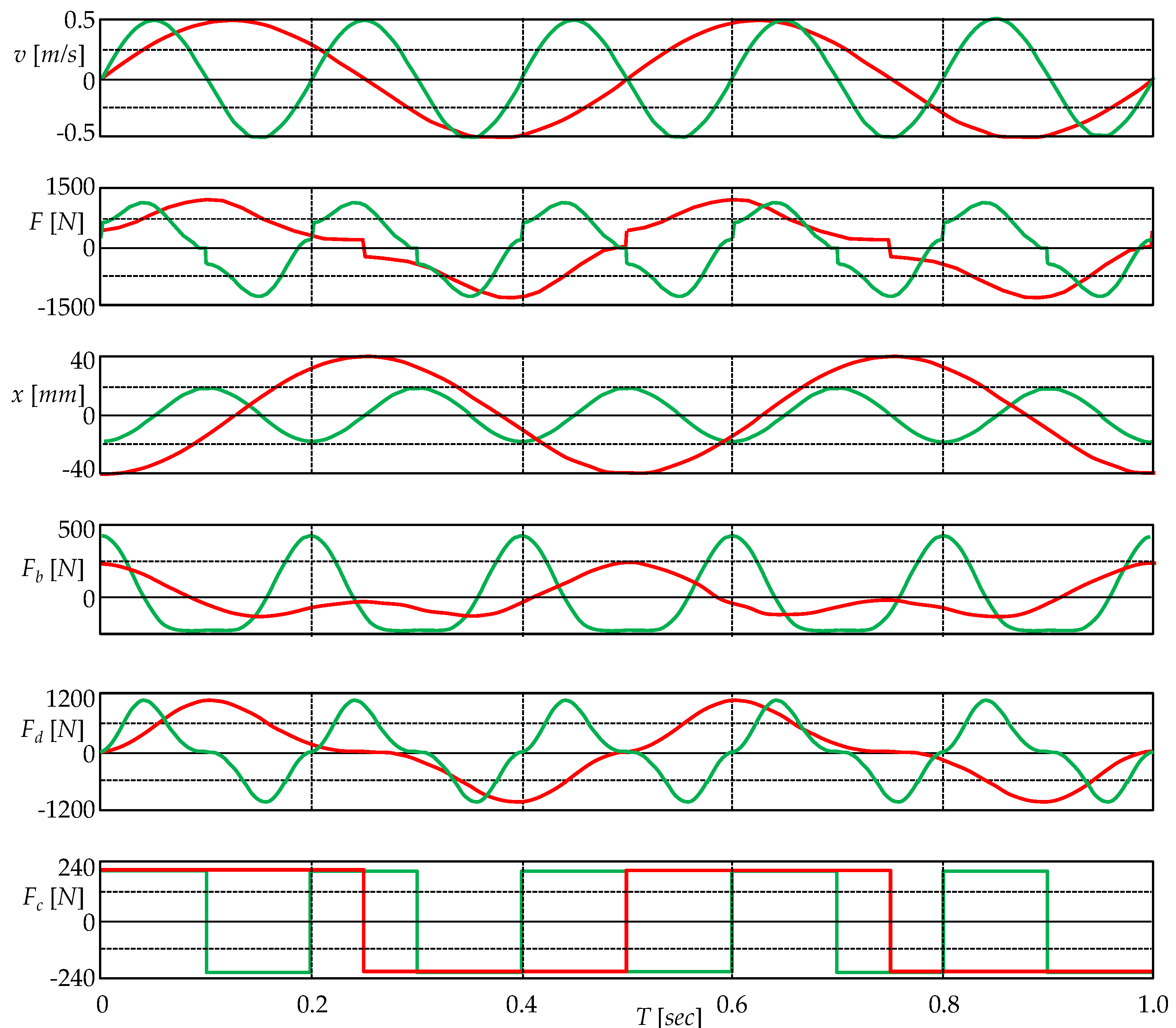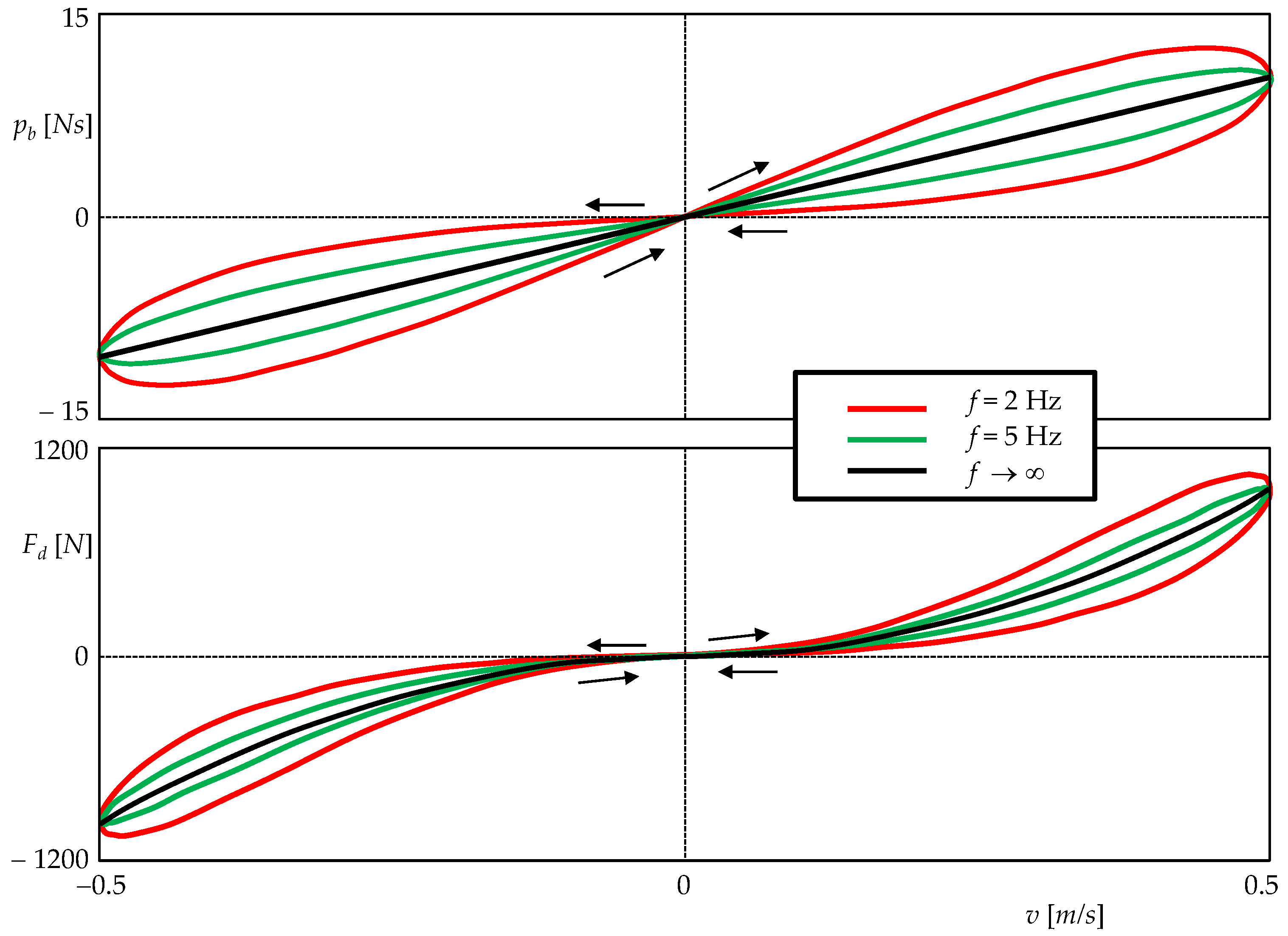Extended and Generic Higher-Order Elements for MEMS Modeling
Abstract
1. Introduction
2. Fingerprints of Extended and Generic HOEs
2.1. Zero-Crossing Property
2.2. Pinched Hysteresis Loop
2.3. High-Frequency Behavior
2.4. Type of PHL
3. Illustrative Example—Fluid Meminerter
3.1. Device Analysis
3.2. Modeling and Simulation
4. Discussion
5. Conclusions
Author Contributions
Funding
Institutional Review Board Statement
Informed Consent Statement
Data Availability Statement
Conflicts of Interest
Appendix A
References
- Chua, L.O. Memristor—The missing circuit element. IEEE Trans. Circ. Theory 1971, 18, 507–519. [Google Scholar] [CrossRef]
- Chua, L.O. Device modeling via nonlinear circuit elements. IEEE Trans. Circ. Syst. 1980, 27, 1014–1044. [Google Scholar] [CrossRef]
- Chua, L.O.; Kang, S.M. Memristive Devices and Systems. Proc. IEEE 1976, 64, 209–223. [Google Scholar] [CrossRef]
- Di Ventra, M.; Pershin, Y.V.; Chua, L.O. Circuit Elements With Memory: Memristors, Memcapacitors, and Meminductors. Proc. IEEE 2009, 97, 1717–1724. [Google Scholar] [CrossRef]
- Chua, L.O. If it’s pinched it’s a memristor. Semicond. Sci. Technol. 2014, 29, 104001. [Google Scholar] [CrossRef]
- Biolek, D.; Biolek, Z.; Biolkova, V. Memristors and other higher-order elements in generalized through-across domain. In Proceedings of the 2016 IEEE International Conference on Electronics, Circuits and Systems (ICECS), Monte Carlo, Monaco, 11–14 December 2016; pp. 604–607. [Google Scholar]
- Wang, B.; Zhu, L.F.; Yang, Y.H.; Xu, N.S.; Yang, G.W. Fabrication of a SnO2 nanowire gas sensor and sensor performance for hydrogen. J. Phys. Chem. C 2008, 112, 6643–6647. [Google Scholar] [CrossRef]
- Carrara, S.; Sacchetto, D.; Doucey, M.A.; Baj-Rossi, C.; De Micheli, G.; Leblebici, Y. Memristive-biosensors: A new detection method by using nanofabricated memristors. Sens. Actuators B 2012, 171, 449–457. [Google Scholar] [CrossRef]
- Zheng, G.; Patolsky, F.; Cui, Y.; Wang, W.U.; Lieber, C.M. Multiplexed electrical detection of cancer markers with nanowire sensor arrays. Nat. Biotechnol. 2005, 23, 1294–1301. [Google Scholar] [CrossRef]
- Hahm, J.; Lieber, C.M. Direct Ultrasensitive Electrical Detection of DNA and DNA Sequence Variations Using Nanowire Nanosensors. Nano Lett. 2004, 4, 51–54. [Google Scholar] [CrossRef]
- Vahl, A.; Carstensen, J.; Kaps, S.; Lupan, O.; Strunskus, T.; Adelung, R.; Faupel, F. Concept and modelling of memsensors as two terminal devices with enhanced capabilities in neuromorphic engineering. Sci. Rep. 2019, 9, 1–9. [Google Scholar] [CrossRef]
- Chiolerio, A.; Roppolo, I.; Cauda, V.; Crepaldi, M.; Bocchini, S.; Bejtka, K.; Verna, A.; Pirri, C.F. Ultraviolet mem-sensors: Flexible anisotropic composites featuring giant photocurrent enhancement. Nano Res. 2015, 8, 1956–1963. [Google Scholar] [CrossRef]
- Najem, J.S.; Taylor, G.J.; Weiss, R.J.; Hasan, M.S.; Rose, G.; Schuman, C.D.; Belianinov, A.; Collier, C.P.; Sarles, S.A. Memristive Ion Channel-Doped Biomembranes as Synaptic Mimics. ACS Nano 2018, 12, 4702–4711. [Google Scholar] [CrossRef] [PubMed]
- Najem, J.S.; Hasan, M.S.; Williams, R.S.; Weiss, R.J.; Rose, G.S.; Taylor, G.J.; Sarles, S.A.; Collier, C.P. Dynamical nonlinear memory capacitance in biomimetic membranes. Nat. Commun. 2019, 10, 1–11. [Google Scholar] [CrossRef] [PubMed]
- Tuszynski, J.A.; Friesen, D.; Freedman, H.; Sbitnev, V.I.; Kim, H.; Santelices, I.; Kalra, A.P.; Patel, S.D.; Shankar, K.; Chua, L.O. Microtubules as Sub-Cellular Memristors. Sci. Rep. 2020, 10, 1–12. [Google Scholar] [CrossRef] [PubMed]
- Stojanović, G.; Paroški, M.; Samardžić, N.; Radovanović, M.; Krstić, D. Microfluidics-Based Four Fundamental Electronic Circuit Elements Resistor, Inductor, Capacitor and Memristor. Electronics 2019, 8, 1–12. [Google Scholar] [CrossRef]
- Biolek, D.; Biolek, Z.; Biolkova, V. Every nonlinear element from Chua’s table can generate pinched hysteresis loops: Generalised homothety theorem. Electron. Lett. 2016, 52, 1744–1746. [Google Scholar] [CrossRef]
- Biolek, Z.; Biolkova, V.; Biolek, D.; Kolka, Z. Modeling of the generic memcapacitors using higher-order multi-ports. Commun. Nonlinear Sci. Numer. Simul. 2022, 113, 106497. [Google Scholar] [CrossRef]
- Biolek, Z.; Biolek, D.; Biolkova, V.; Kolka, Z. Predictive Modeling of MEMS via Generic Meminductors: The Multiport Inductor Approach. In IEEE Journal on Emerging and Selected Topics in Circuits and Systems; IEEE: Piscataway, NJ, USA, 2022. [Google Scholar]
- Biolek, D.; Biolek, Z.; Biolkova, V.; Kolka, Z. Some fingerprints of ideal memristors. In Proceedings of the 2013 IEEE International Symposium on Circuits and Systems (ISCAS), Beijing, China, 19–23 May 2013; pp. 201–204. [Google Scholar]
- Prodromakis, T.; Toumazou, C.; Chua, L. Two centuries of memristors. Nat. Mater. 2012, 11, 478–481. [Google Scholar] [CrossRef]
- Pershin, Y.V.; Di Ventra, M. Memory effects in complex materials and nanoscale systems. Adv. Phys. 2011, 60, 145–227. [Google Scholar] [CrossRef]
- Biolek, Z.; Biolek, D. How Can the Hysteresis Loop of the Ideal Memristor Be Pinched? IEEE Trans. Circ. Syst. II 2014, 61, 491–495. [Google Scholar] [CrossRef]
- Biolek, Z.; Biolek, D.; Biolkova, V.; Kolka, Z. Comments on Pinched Hysteresis Loops of Memristive Elements. Radioengineering 2015, 24, 962–967. [Google Scholar] [CrossRef]
- Smith, M.C. Synthesis of Mechanical Networks: The Inerter. IEEE Trans. Aut. Contr. 2002, 47, 1648–1662. [Google Scholar] [CrossRef]
- Swift, S.J.; Smith, M.C.; Glover, A.R.; Papageorgiou, C.; Gartner, B.; Houghton, N.E. Design and modelling of a fluid inerter. Int. J. Control 2013, 86, 2035–2051. [Google Scholar] [CrossRef]
- Zhang, X.L.; Geng, C.; Nie, J.M.; Gao, Q. The missing mem-inerter and extended mem-dashpot found. Nonlinear Dyn. 2020, 101, 835–856. [Google Scholar] [CrossRef]
- Karnoop, D.C.; Rosenberg, R.C. Analysis and Simulation of Multiport Systems: The Bond Graph Approach to Physical System Dynamics; MIT Press: Cambridge, MA, USA, 1968. [Google Scholar]
- Biolek, D.; Biolek, Z.; Biolkova, V. Pinched hysteretic loops of ideal memristors, memcapacitors and meminductors must be ‘self-crossing’. Electron. Lett. 2011, 47, 1385–1387. [Google Scholar] [CrossRef]
- Falkovich, G. Fluid Mechanics (A Short Course for Physicists); Cambridge University Press: Cambridge, UK, 2011. [Google Scholar]
- Mott, N.F.; Gurney, R.W. Electronic Processes in Ionic Crystals; Clarendon Press: Oxford, UK, 1950. [Google Scholar]





| Element | y | u | e: P(x,u); g: P(x) |
|---|---|---|---|
Extended and Generic Memristor | Voltage v = v(0) | Current i = i(0) | Resistivity e: R(x,i), g: R(x) |
| Current i = i(0) | Voltage v = v(0) | Conductance e: G(x,v), g: G(x) | |
Extended and Generic Memcapacitor | Charge q = i(−1) | Voltage v = v(0)) | Capacitance e: C(x,v), g: C(x) |
| Voltage v = v(0)) | Charge q = i(−1) | Elastance e: D(x,q), g: D(x) | |
Extended and Generic Meminductor | Flux φ = v(−1) | Current i = i(0) | Inductance e: L(x,i), g: L(x) |
| Current i = i(0) | Flux φ = v(−1) | Reluctance e: Λ(x,φ), g: Λ(x) | |
| Extended and Generic (α,β) element  | y = v(α+1) | u = i(β+1) | Common parameter P e: P(x,i(β+1)), g: P(x) |
y = i(β+1) | u = v(α+1) | Dual parameter Pd e: Pd(x,v(α+1)), g: Pd(x) |
| Mechanical Variables | Electrical Variables | |
|---|---|---|
| F-i | F-v | |
| Force | Current | Voltage |
| Momentum | Charge | Flux |
| TIM 1 | TIC 2 | TIF 3 |
| Velocity | Voltage | Current |
| Displacement | Flux | Charge |
| Absement | TIF 3 | TIC 2 |
Publisher’s Note: MDPI stays neutral with regard to jurisdictional claims in published maps and institutional affiliations. |
© 2022 by the authors. Licensee MDPI, Basel, Switzerland. This article is an open access article distributed under the terms and conditions of the Creative Commons Attribution (CC BY) license (https://creativecommons.org/licenses/by/4.0/).
Share and Cite
Biolek, Z.; Biolková, V.; Biolek, D.; Kolka, Z. Extended and Generic Higher-Order Elements for MEMS Modeling. Sensors 2022, 22, 8007. https://doi.org/10.3390/s22208007
Biolek Z, Biolková V, Biolek D, Kolka Z. Extended and Generic Higher-Order Elements for MEMS Modeling. Sensors. 2022; 22(20):8007. https://doi.org/10.3390/s22208007
Chicago/Turabian StyleBiolek, Zdeněk, Viera Biolková, Dalibor Biolek, and Zdeněk Kolka. 2022. "Extended and Generic Higher-Order Elements for MEMS Modeling" Sensors 22, no. 20: 8007. https://doi.org/10.3390/s22208007
APA StyleBiolek, Z., Biolková, V., Biolek, D., & Kolka, Z. (2022). Extended and Generic Higher-Order Elements for MEMS Modeling. Sensors, 22(20), 8007. https://doi.org/10.3390/s22208007








